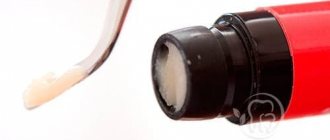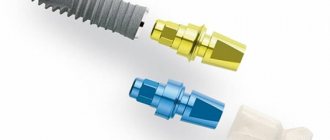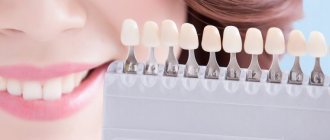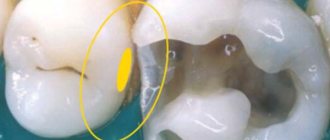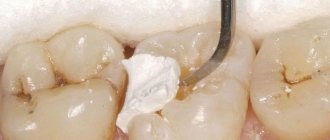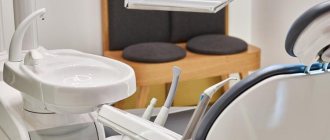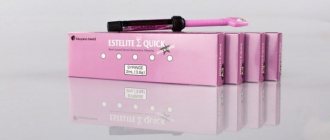When a tooth is destroyed, caries forms, or a filling is lost, the question of filling arises. Any defect in dentistry can be replaced using various types of fillings . Conservative therapeutic intervention allows you to stop the spread of caries and maintain an aesthetic appearance.
Dental clinics today use various types of materials : cement, plastic, ceramics, photopolymer components. One filling material is suitable for the front teeth, the other for the lateral and chewing elements of the dental system. In each case, the choice takes into account the clinical picture, the degree of pathology and possible contraindications.
Classification of filling materials
Depending on its purpose, the filling composition can be temporary or permanent. For the first, a less durable material is used, since the dental filling is designed for a short period. It is usually installed in cases of pulpitis to isolate the diseased unit. Permanent ones are made from more durable materials; they are usually designed to last for several decades. The process of setting them up is longer and more scrupulous. Let's take a closer look at each of the options.
Temporary filling
A filling composition that is diagnostic. It is made from artificial dentin using special medicinal additives. The main purpose is to isolate the tooth cavity. It performs an important protective function, preventing the spread of infection and the accumulation of food debris. It is usually installed before nerve extraction. The doctor removes damaged enamel and dentin, cleans the canals, and then installs a special dental filling made of a certain material.
The temporary filling material must meet the following criteria.
- Effective sealing.
- Resistance to the influence of medicinal drugs.
- Easy to remove.
- No allergic reactions or toxic effects.
- Excellent ductility.
- Fast hardening properties.
A temporary filling composition is installed for a certain period of time, from a couple of days to several weeks. What material are these fillings made of? most often used in clinics are Vinoxol, Sympath and special cement-containing compounds. Their advantages include the fact that they do not have a negative effect on the tissue of the dentition element, they have good adhesion and sealing properties.
Permanent filling
The filling material is characterized by increased strength and wear resistance, and has the required coefficient of thermal expansion. Various types of permanent dental fillings are installed for a long time. Their main task is to hermetically seal the cavity of an element of the dental system, protect against the spread of a pathogenic environment and give the dental unit an impeccable appearance. In each case, a suitable option is selected. For example, for chewing dental units, various types of cement fillings are used, and for the anterior ones, compositions based on photopolymers are used.
Modern filling materials for permanent fillings must meet certain requirements.
- Good adhesion. Excellent connection with the tissues of the dental unit.
- No toxic effects on the body.
- Increased resistance to any chemical attack.
- Mechanical strength. The light-polymer filling must withstand significant loads.
- Good marginal seal. The composition should adhere tightly to the walls of the arious cavity and adjacent tissues.
- Increased wear resistance. Composite filling materials should not lose their properties when in contact with abrasive substances.
- High aesthetic performance.
When using various dental compounds, it is important to follow standards, regulations and relevant protocols. This will ensure a long service life of the filling component.
We looked at what fillings are and what important characteristics they must meet. In each case, you should consult a specialist. The doctor will be able to explain the difference between a gutta-percha filling and a light-polymer filling. In each case, functional load, possible diseases and contraindications are taken into account.
Criterias of choice
The choice of a specific material for filling children's teeth is made taking into account the structural features of the “milk jugs”. These include a thin layer of enamel and wide dentin tubules, which facilitate the penetration of pathogenic bacteria into the pulp.
The pulp chamber is larger relative to the size of the tooth than in adults (the wall is thin).
The pulp horns are located high, which creates the risk of rapid connection of the carious cavity with the pulp chamber. Adhesive materials used for temporary teeth must provide good adhesion so that it is possible to avoid creating special retention forms prepared for filling the cavity , which is dangerous due to the risk of exposing the pulp.
Temporary units also have features in morphology that distinguish them from permanent teeth - a short crown, a narrowed neck, a large gingival papilla.
Due to the relatively low pressure on milk jugs when chewing, and the short period of their existence, filling materials with lower strength parameters can be used for children.
This makes it possible to use glass ionomer cements, which are less durable than composites, when treating children. Despite limited strength parameters, GICs have good sealing and adhesive properties, are hydrophilic and bioactive due to fluorine.
At the same time, due to the thin walls of primary teeth and wide dentin tubules, a contraindication for the use of certain filling materials is their irritating, toxic effect on the pulp.
Types of materials for dental fillings
Dental clinics today use various filling compounds. More information about the names of fillings and materials used can be obtained directly from your doctor. Filling materials are made based on the following components:
- Amalgam. A metal filling compound that is strong and durable. Quite rarely used in practice. The advantages include strength and abrasion resistance. The disadvantages are unaesthetic and the risk of developing allergies. There are contraindications.
- Cement. The main material for chemical fillings. The most commonly used powder is zinc oxide with the addition of silicon and magnesium. The advantages are affordable cost, ease of installation, and reduced risk of developing recurrent caries. The downside is quick erasing and poor aesthetics.
- Plastic. Composite product for durability and reliability. The best option when you don’t know what filling to put on a tooth and have a limited budget. Compositions based on acrylic acids are especially popular. They are distinguished by good durability and the ability to select colors. The downside is the high risk of microscopic pores.
- Photopolymers. Light-curing filling materials are the most popular today. The paste mixture hardens under the influence of ultraviolet light. The advantages are natural shine, strength, aesthetics, minimal toxicity. A light seal made of photopolymer material is practically free of disadvantages.
- Composites. Plastic products with special inorganic fillers. Among them is a gutta-percha filling. It is distinguished by strength, indelibility, and resistance to external factors. Used as a filling material for root canals.
- GIC (glass ionomer cements). High-strength filling material used for fixing crowns. Has excellent adhesion to metal and ceramic products.
More information about glass ionomer and light-based fillings can be obtained directly from your dentist. The choice of filling composition must be approached responsibly and trusted by your attending physician, since the performance of the chewing function will depend on this. At our AlphaDent dental clinic you can get detailed advice on selecting the necessary filling to suit your individual characteristics.
Experts' opinions
Experts recommend compomers and condensable chemically cured glass ionomer cements as the main materials for filling temporary teeth. Compomers can be used on any surface, including chewing surfaces. They are applied in layers with each layer cured with light.
Some brands of compomers have colors that are attractive to children. These are the materials that experts prefer over others. They are produced under various brands and brands - Riva Light Cure, Fuji II LC, Ionolux, Photac-Fil.
Condensable glass ionomer cements contain no organic components and have a chemical cure that begins after mixing the powder and liquid. They are applied to prepared carious cavities at a time by rubbing (that’s why they are condensed).
They have lower strength than compomers. They are recommended for use on proximal and vestibulo-oral surfaces for relatively small lesions with the obligatory use of a bond.
The strength of GIC fillings can be increased by applying a protective varnish, but in this case, the release and penetration of fluoride into dentin is difficult . If there is a need to install a large GIC filling, it is advisable to cover it with a crown for strength.
The main brands of condensed GIC: Riva Self Cure, Ketac Molar, Ionofil Molar, Fuji IX, Chemfil Rock.
Where to go
You can make an appointment with a dentist in Ivanteevka at our Sanident clinic. We provide all types of dental care to patients from Shchelkovo and the urban district of Ivanteevka.
In case of significant damage in the oral cavity, our specialists:
- install pins of various types;
- restore the angle of the tooth;
- carry out complete anatomical restoration of the coronal part and other types of work.
High-quality filling and anesthetic materials are used for treatment.
A consultation with a dentist at the Sanident clinic is your first step to a healthy smile!
What is tooth extension on a pin?
A pin is a small rod whose purpose is to strengthen the entire structure. It is installed in the root canal.
Tooth extension onto a pin may be required if:
- chipped teeth and cracks;
- enamel damage;
- violation of the integrity of the tooth as a result of trauma;
- loss of part of the tooth surface as a result of caries.
The most commonly used pins are:
- anchor - made from high-strength materials, they allow you to restore even the most severe damage. An important condition for their installation is healthy root canals;
- fiberglass - hypoallergenic and safe. Their main advantages are that they are easy to install, not subject to discoloration and corrosion;
- titanium - used when it is necessary to restore large damage.
The design of the pin is selected depending on the degree of destruction, as well as in accordance with the wishes and financial capabilities of the patient.
How does the procedure work?
Sequence of actions when filling teeth:
- An insulating gasket is applied (if necessary);
- The tooth surface is treated with adhesive;
- The doctor carefully introduces the material into the cavity, after which he compacts it well;
- The dentist models the filling;
- For photopolymer fillings - exposure to a special lamp is carried out for rapid hardening;
- Grinding and polishing is carried out.
The filling should be comfortable and not interfere with biting. If you experience the slightest inconvenience, you should inform your doctor; adjusting the filling is a matter of a few seconds.
Reviews
Usually, when installing fillings, dentists do not inform the patient of all the technological details of the treatment. But, at the same time, no one is stopping parents from asking what material their baby will wear a filling from.
If you filled your child’s temporary teeth, please share information about what material was used for this, and whether the filling lasted until the temporary tooth was replaced with a permanent one? You can leave a review at the bottom of this page.
If you find an error, please select a piece of text and press Ctrl+Enter.
Seal tags
Did you like the article? stay tuned
No comments yet
